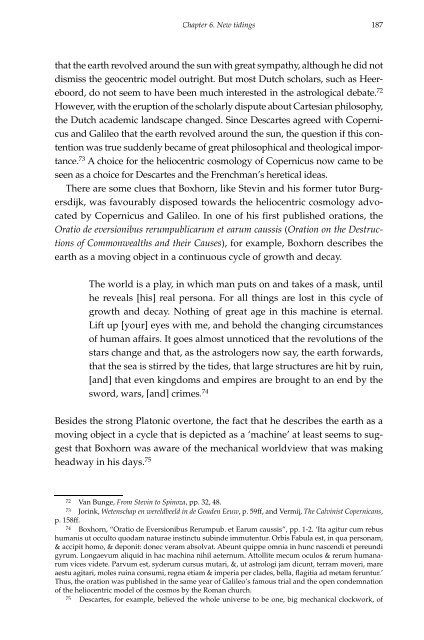historical and political thought in the seventeenth - RePub - Erasmus ...
historical and political thought in the seventeenth - RePub - Erasmus ...
historical and political thought in the seventeenth - RePub - Erasmus ...
You also want an ePaper? Increase the reach of your titles
YUMPU automatically turns print PDFs into web optimized ePapers that Google loves.
Chapter 6. New tid<strong>in</strong>gs<br />
that <strong>the</strong> earth revolved around <strong>the</strong> sun with great sympathy, although he did not<br />
dismiss <strong>the</strong> geocentric model outright. But most Dutch scholars, such as Heereboord,<br />
do not seem to have been much <strong>in</strong>terested <strong>in</strong> <strong>the</strong> astrological debate. 72<br />
However, with <strong>the</strong> eruption of <strong>the</strong> scholarly dispute about Cartesian philosophy,<br />
<strong>the</strong> Dutch academic l<strong>and</strong>scape changed. S<strong>in</strong>ce Descartes agreed with Copernicus<br />
<strong>and</strong> Galileo that <strong>the</strong> earth revolved around <strong>the</strong> sun, <strong>the</strong> question if this contention<br />
was true suddenly became of great philosophical <strong>and</strong> <strong>the</strong>ological importance.<br />
73 A choice for <strong>the</strong> heliocentric cosmology of Copernicus now came to be<br />
seen as a choice for Descartes <strong>and</strong> <strong>the</strong> Frenchman’s heretical ideas.<br />
There are some clues that Boxhorn, like Stev<strong>in</strong> <strong>and</strong> his former tutor Burgersdijk,<br />
was favourably disposed towards <strong>the</strong> heliocentric cosmology advocated<br />
by Copernicus <strong>and</strong> Galileo. In one of his first published orations, <strong>the</strong><br />
Oratio de eversionibus rerumpublicarum et earum caussis (Oration on <strong>the</strong> Destructions<br />
of Commonwealths <strong>and</strong> <strong>the</strong>ir Causes), for example, Boxhorn describes <strong>the</strong><br />
earth as a mov<strong>in</strong>g object <strong>in</strong> a cont<strong>in</strong>uous cycle of growth <strong>and</strong> decay.<br />
187<br />
The world is a play, <strong>in</strong> which man puts on <strong>and</strong> takes of a mask, until<br />
he reveals [his] real persona. For all th<strong>in</strong>gs are lost <strong>in</strong> this cycle of<br />
growth <strong>and</strong> decay. Noth<strong>in</strong>g of great age <strong>in</strong> this mach<strong>in</strong>e is eternal.<br />
Lift up [your] eyes with me, <strong>and</strong> behold <strong>the</strong> chang<strong>in</strong>g circumstances<br />
of human affairs. It goes almost unnoticed that <strong>the</strong> revolutions of <strong>the</strong><br />
stars change <strong>and</strong> that, as <strong>the</strong> astrologers now say, <strong>the</strong> earth forwards,<br />
that <strong>the</strong> sea is stirred by <strong>the</strong> tides, that large structures are hit by ru<strong>in</strong>,<br />
[<strong>and</strong>] that even k<strong>in</strong>gdoms <strong>and</strong> empires are brought to an end by <strong>the</strong><br />
sword, wars, [<strong>and</strong>] crimes. 74<br />
Besides <strong>the</strong> strong Platonic overtone, <strong>the</strong> fact that he describes <strong>the</strong> earth as a<br />
mov<strong>in</strong>g object <strong>in</strong> a cycle that is depicted as a ‘mach<strong>in</strong>e’ at least seems to suggest<br />
that Boxhorn was aware of <strong>the</strong> mechanical worldview that was mak<strong>in</strong>g<br />
headway <strong>in</strong> his days. 75<br />
72 Van Bunge, From Stev<strong>in</strong> to Sp<strong>in</strong>oza, pp. 32, 48.<br />
73 Jor<strong>in</strong>k, Wetenschap en wereldbeeld <strong>in</strong> de Gouden Eeuw, p. 59ff, <strong>and</strong> Vermij, The Calv<strong>in</strong>ist Copernicans,<br />
p. 158ff.<br />
74 Boxhorn, “Oratio de Eversionibus Rerumpub. et Earum caussis”, pp. 1-2. ‘Ita agitur cum rebus<br />
humanis ut occulto quodam naturae <strong>in</strong>st<strong>in</strong>ctu sub<strong>in</strong>de immutentur. Orbis Fabula est, <strong>in</strong> qua personam,<br />
& accipit homo, & deponit: donec veram absolvat. Abeunt quippe omnia <strong>in</strong> hunc nascendi et pereundi<br />
gyrum. Longaevum aliquid <strong>in</strong> hac mach<strong>in</strong>a nihil aeternum. Attollite mecum oculos & rerum humanarum<br />
vices videte. Parvum est, syderum cursus mutari, &, ut astrologi jam dicunt, terram moveri, mare<br />
aestu agitari, moles ru<strong>in</strong>a consumi, regna etiam & imperia per clades, bella, flagitia ad metam feruntur.’<br />
Thus, <strong>the</strong> oration was published <strong>in</strong> <strong>the</strong> same year of Galileo’s famous trial <strong>and</strong> <strong>the</strong> open condemnation<br />
of <strong>the</strong> heliocentric model of <strong>the</strong> cosmos by <strong>the</strong> Roman church.<br />
75 Descartes, for example, believed <strong>the</strong> whole universe to be one, big mechanical clockwork, of

















